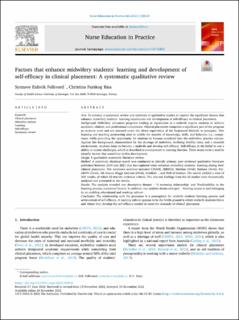| dc.contributor.author | Folkvord, Synnøve Mari Eidsvik | |
| dc.contributor.author | Furskog-Risa, Christina | |
| dc.date.accessioned | 2023-01-04T07:35:45Z | |
| dc.date.available | 2023-01-04T07:35:45Z | |
| dc.date.created | 2022-12-01T12:13:24Z | |
| dc.date.issued | 2022 | |
| dc.identifier.citation | Folkvord, S. E., & Risa, C. F. (2022). Factors that enhance midwifery students’ learning and development of self-efficacy in clinical placement: a systematic qualitative review. Nurse Education in Practice, 103510. | en_US |
| dc.identifier.issn | 1471-5953 | |
| dc.identifier.uri | https://hdl.handle.net/11250/3040815 | |
| dc.description.abstract | Aim
To conduct a systematic review and synthesis of qualitative studies to explore the significant factors that enhance midwifery students’ learning experiences and development of self-efficacy in clinical placement.
Background
Midwifery education programs leading to registration as a midwife require students to achieve academic, clinical, and professional competence. Clinical placement comprises a significant part of the program as students work and are assessed under the direct supervision of the Registered Midwife or preceptor. This learning and teaching partnership aims to enable the transfer of knowledge, skills, and behavior, i.e., competence, while providing the opportunity for students to become socialized into the midwifery practice culture. Against this background, characterized by the shortage of midwives, declining fertility rates, and a stressful environment, students learn to become a midwife and develop self-efficacy. Self-efficacy is the belief in one’s ability to master challenges, which is described as a component in learning theories. There seems to be a need to identify factors that contribute to this development.
Design
A qualitative systematic literature review.
Method
A systematic database search was conducted to identify primary peer reviewed qualitative literature published between 2000 and 2021 that has explored what enhances midwifery students' learning during their clinical placement. The databases searched included CINAHL (EBSCO), Medline (Ovid), Embase (Ovid), PsycINFO (Ovid), JBI Joanna Briggs Institute (Ovid), SveMed+ , and Web of Science. The search yielded a total of 354 results, of which 22 met the inclusion criteria. The relevant findings from the 22 studies were thematically analyzed and presented in the results.
Results
The analysis revealed two descriptive themes – ‘A nurturing relationship’ and ‘Predictability in the learning process, contextual factors. In addition, one analytic theme emerged – ‘Gaining access to and belonging in an enabling educational and working culture'.
Conclusion
The relationship with the preceptor is a prerequisite for midwife students learning process and achievement of self-efficacy. A learning culture appears to be the fertile ground in which midwife students thrive and where they develop the self-efficacy needed to meet the demands of clinical placement. | en_US |
| dc.language.iso | eng | en_US |
| dc.publisher | Elsevier | en_US |
| dc.rights | Navngivelse 4.0 Internasjonal | * |
| dc.rights.uri | http://creativecommons.org/licenses/by/4.0/deed.no | * |
| dc.title | Factors that enhance midwifery students’ learning and development of self-efficacy in clinical placement: A systematic qualitative review | en_US |
| dc.title.alternative | Factors that enhance midwifery students’ learning and development of self-efficacy in clinical placement: A systematic qualitative review | en_US |
| dc.type | Peer reviewed | en_US |
| dc.type | Journal article | en_US |
| dc.description.version | publishedVersion | en_US |
| dc.rights.holder | The author | en_US |
| dc.subject.nsi | VDP::Medisinske Fag: 700 | en_US |
| dc.source.volume | 66 | en_US |
| dc.source.journal | Nurse Education in Practice | en_US |
| dc.identifier.doi | 10.1016/j.nepr.2022.103510 | |
| dc.identifier.cristin | 2086967 | |
| cristin.ispublished | true | |
| cristin.fulltext | original | |
| cristin.qualitycode | 1 | |

